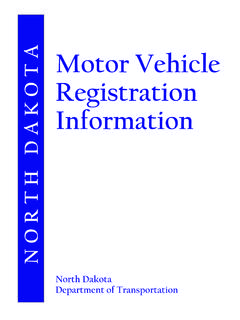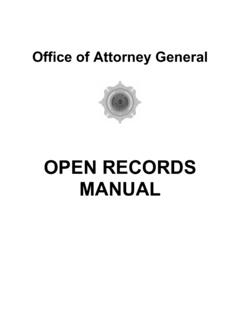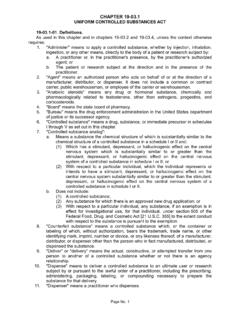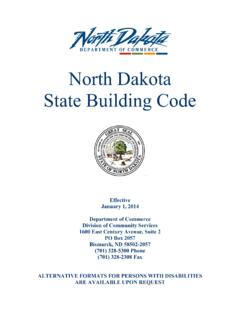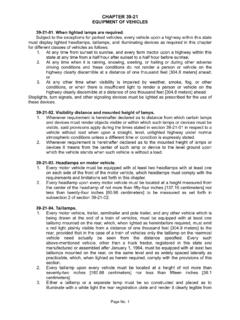Transcription of Data Analysis using SPSS - University of North Dakota
1 DATA Analysis using SPSSDr. Mark Williamson, PhD (based on PDF of Andrew Garth, Sheffield Hallam University )Purpose The intent of this presentation is to teach you to explore, analyze, and understand data The software used is spss (Statistical Package for the Social Sciences) commonly used in social sciences and health fields as opposed to other statistical software such as SAS or R, it requires little to no coding background This presentation is heavily indebted to the work of Andrew Garth (Sheffield Hallam University ) and his full document can be found at the link below: All the data files used in this presentation can be found at the link below (download the ): First, we will look at the Big Picture Next, we ll define our terms Then, we ll get set up for working in spss Only then will we get into the meat of things, which will focus on aspects of data Analysis Descriptive Statistics and Graphs (Exploring our Data) Inferential Statistics (Analyzing our Data, and Interpreting our Results)The Big depends on the nature of the dataand what questions you want to answer How should I analyze my data?
2 To answer those questions, you need to explore your data. and select the proper your at Question (Hypothesis) your up and run appropriate your the Test Statistic, DF, and if if null hypothesis rejected or appropriate plotBig Picture Steps in Statistical AnalysisBefore we can start Analysis , we need to get set up on the basics Defining Terms Working in SPSSD efining Terms There are two basic data types, each with two sub-types Numerical: expressed by numbers Discrete: numbers take on integer values only (number of children, number of siblings) Continuous: numbers can take on decimal values (height, weight) Categorical.
3 Expressed by categories (also known as factors/groups) Nominal: no meaningful order between categories (gender, occupation) Ordinal: categories can be put in meaningful order (agreement, level of pain, etc.) If data is not used for Analysis , it can be labeled as a nuisance or bookkeeping variableDefining Terms 2 Data can also be paired or unpaired Paired: categories are related to one another Often result of before and after situations (treatments/events) Since each part of the pair is related to each other, this needs to be considered If there are pairs of higher than 2, this is called repeated measures Unpaired: categories are not related to one another Numerical data can be parametric or non-parametric Simply put, parametric data approximately fits a normal distribution Data are symmetric around a central point Bell curve Also known as normally distributed Data must be parametric (normally distributed) for many statistical tests If the data are not parametric, you cannot use the test results If the data are non-parametric (does not fit a normal distribution), there are non-parametric tests for use, but they are weakerDefining Terms 3 Recap Data can be.
4 Numerical, categorical, or nuisance Paired or unpaired Parametric or non-parametric (usually must run a test to tell)Examples Numerical continuous: height, weight, drug concentration Numerical discrete: number of siblings, number of drinks in a day, flower petal number Categorical ordinal: time of day (morning, noon, night), position (assistant professor, associate professor, department chair, dean) Categorical nominal: flower color, college major, drug treatment (A, B, C) Nuisance: sample number, subject name, date, id number Paired: Before, during, and after treatment; pre-and post-disasterDefining Terms 4 For statistical tests, we use two types of variables: Independent Variable-variation does not depend on another variable Usually denoted as X Typically represents what the researcher set up (treatment, group, etc.)
5 Dependent Variable value depends on another variable (the independent one) Usually denoted as Y Represents the variable that the researcher is interested in Output or outcome Almost all statistical tests give three important pieces of information Test statistic Variable calculated from sample data and used in hypothesis test Used to determine whether a test was significant or not Degrees of Freedom Number of values of quantities that can be assigned to a statistical distribution Should be reported with test results P-value Measure of significance for the test statistic Typically is the cutoff valueAssessment types of data (categorical [nominal, ordinal], numerical [discrete, continuous])
6 Are each of the following examplesa)Number of vaccine shots administeredb)Highest level of education attained (high school, bachelors, masters, PhD)c)Country of origind)Tumor the boxplot graph to the right, which axis is the independent variable plotted on? Which axis is the dependent variable plotted on? the table to the right, label each of the columns as numerical, categorical, or nuisanceSample #User 1 types of data (categorical [nominal, ordinal], numerical [discrete, continuous] are each of the following examplesa)Number of vaccine shots administered (numerical discrete)b)Highest level of education attained (high school, bachelors, masters, PhD) (categorical ordinal)c)Country of origin (categorical nominal)d)Tumor diameter (numerical continuous) the graph to the right which axis is the independent variable plotted on?
7 Which axis is the dependent variable plotted on? Independent on X-axis (Treatment), Dependent on Y-axis (Inflammation) the table to the right, label each of the columns as numerical, categorical, or nuisance (nuisance, nuisance, numerical, categorical, categorical)Sample #User in spss : Access You can get access to spss using the CitrixWorkspaceAppfor UND Some UND computers also have it downloaded If all else fails, you can try a free trial ( ) From here on out, I will be using the following boxes with green border are instructions in will guide you through how to do the exploration/ Analysis I show boxes with purple borders are boxes with red border are general step outlinesBlue boxes are remindersStarting in spss : Data Format Specifics of format depends on the kind of data Principles that apply in most case goes in its own variables are best represented by numbers (even though they are not).
8 Can be labeled with Variable Labels names for the columns are limited in length, so again can be labeled with Variable Labels groups of subjects should still be set up with each case having its own row: create a new variable column and give it the group labelStarting in spss : Entering data There are two ways to enter data into spss Manually (entering the data by hand) Loading in a file (data is saved in some form and can be opened in spss ) Let s try manual first You can look at the data in two ways Variable View Data View spss gives a lot of information, most which you don t need Ignore what you don t spss from wherever you have it click New Dataset at the top the box on the right there are 10 people s names, type them into the first may notice a problem when you get to has 5 letters in his name, unfortunately spss has assumed all the cases are similar to the first one and Peter has become Pete.
9 Can alter this by switching to the Variable View (click the tab at the bottom of the spss window). You should see a row of information about variable one (var0001), which is where we are storing these names. the Width from 4 to 12. back to the Data View and type in Peter again. typing the back to the Variable View and change the column name (variable) to person rather than the same for var00002, replacing it with the name age .Starting in spss : Saving data Graphs and analyses will not be saved unless you save them specially Save often It is good practice to have multiple copies of data (especially when working on original data) save the names and ages from the previous slide, choose Savefrom the Filemenu.
10 Call it peopleand put your name at the end of the word (ex. peopleAnderson). can save anywhere you want by using the Look in: and selecting the appropriate save graphs or analyses, we need to do an Analysis on the Analyze menu and choose Descriptive Statistics, then button between the two windows let you choose the variables to be analyzed, in our case the choice is simple, just click the center button to move the age variable over to the right then click OK. should display the results in a separate window, you will see this appear in front of the Data Editor and a new button will appear on the Windows task bar at the bottom of your screen.
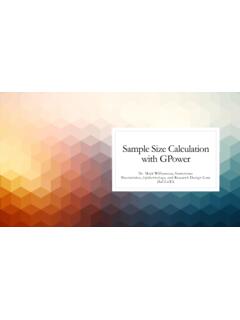


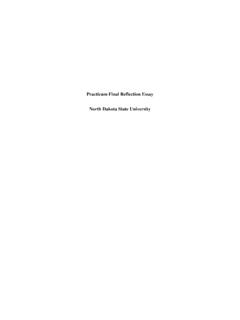
![BCA160 Macrame [2015] - North Dakota State University](/cache/preview/a/a/f/9/7/9/5/e/thumb-aaf9795e3911f0cd6b61ff29c8d644fb.jpg)
